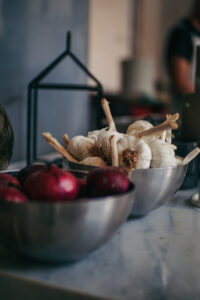If you’re an aspiring chef or just someone who loves spending time in the kitchen, you’ve probably wondered about the best type of cookware to invest in. With so many options available, it can be overwhelming to choose the right pots and pans for your culinary adventures. From stainless steel to cast iron, each material has its unique benefits and drawbacks. In this article, we will explore the various types of cookware and help you navigate through the sea of options, so you can make an informed decision and elevate your cooking game to new heights.
Durability and Longevity
Stainless Steel
Stainless steel cookware is well-known for its exceptional durability and longevity. It is highly resistant to rust, corrosion, and staining, making it a popular choice for many households. Stainless steel cookware is also scratch-resistant, ensuring that it stays in excellent condition for years to come. This type of cookware is often made with multiple layers of stainless steel and other metals, which enhances its strength and longevity. With proper care and maintenance, stainless steel cookware can truly withstand the test of time.
Cast Iron
If you’re looking for cookware that will last a lifetime and beyond, cast iron is an excellent choice. Cast iron cookware is incredibly sturdy and can withstand high heat, making it perfect for versatile cooking methods such as frying, sautéing, baking, and even grilling. The thickness and density of cast iron make it highly durable, and with proper seasoning and maintenance, it develops a natural non-stick surface that improves with each use. Cast iron cookware has been passed down through generations, becoming treasured family heirlooms.
Carbon Steel
carbon steel cookware shares many similarities with cast iron in terms of durability and longevity. It is made from a combination of iron and carbon, which gives it excellent heat retention capabilities and exceptional durability. Carbon steel pans are built to withstand high temperatures, making them perfect for searing and achieving a beautiful caramelization on meats and vegetables. With proper seasoning, carbon steel cookware develops a natural non-stick surface, making it more convenient to cook with over time. Its durability ensures that it can withstand heavy use and become a reliable companion in your kitchen.
Heat Conductivity
Copper
Copper has long been recognized for its superior heat conductivity properties. When it comes to cookware, copper excels in evenly distributing heat across the cooking surface, allowing for precise temperature control. copper cookware heats up quickly and responds rapidly to changes in heat, eliminating any hot spots that may occur during cooking. This type of cookware is particularly valued by professional chefs and culinary enthusiasts who prioritize precise cooking control and responsiveness.
Aluminum
Aluminum cookware is renowned for its excellent heat conductivity. It heats up quickly and evenly distributes heat across the surface, ensuring that your food cooks evenly without any burn spots. Aluminum cookware is relatively lightweight, making it easy to handle in the kitchen. However, pure aluminum cookware can react with certain acidic foods, resulting in a metallic taste. To combat this issue, most aluminum cookware is now coated with a non-reactive layer, such as stainless steel or non-stick coating.
Carbon Steel
Carbon steel cookware, similar to cast iron, possesses great heat conductivity properties. It heats up quickly and evenly, allowing for efficient and precise cooking. The high heat retention capabilities of carbon steel make it ideal for searing or stir-frying dishes that require quick, high-temperature cooking. The even heat distribution ensures that your food cooks uniformly, reducing the risk of hot spots or unevenly cooked meals.

This image is property of images.pexels.com.
Non-Stick Properties
Ceramic
Ceramic cookware has gained popularity due to its non-stick properties without the use of chemical coatings like Teflon. It’s a healthier alternative for those who prioritize avoiding potentially harmful substances in their cookware. Ceramic coatings are made from natural materials and are generally safe to use. However, it’s important to note that the durability and longevity of ceramic cookware may not match that of other materials, and proper care must be taken to prevent chipping or scratching the surface.
Hard-Anodized Aluminum
Hard-anodized aluminum cookware is a popular choice for those seeking non-stick properties combined with excellent durability. The anodization process creates a non-reactive and non-stick surface that is resistant to scratching and corrosion. Hard-anodized aluminum cookware is known for its even heat distribution, allowing for precise cooking control and preventing hot spots. This type of cookware is highly durable and can withstand the rigors of daily use, making it an excellent investment for any kitchen.
Teflon
Teflon-coated cookware, often referred to as non-stick cookware, has long been favored for its exceptional non-stick properties. The smooth and slippery surface of Teflon prevents food from sticking, making it easier to cook delicate foods and simplifying the cleaning process. However, there are concerns regarding the potential release of toxic fumes when Teflon is subjected to high heat. To ensure safety, it is essential to use Teflon-coated cookware within the recommended temperature range and avoid using metal utensils that could scratch or damage the surface.
Versatility and Multi-Functionality
Stainless Steel
Stainless steel cookware is highly versatile and can handle a wide range of cooking methods. Whether you’re sautéing, boiling, frying, or even baking, stainless steel cookware can adapt to various cooking needs. It can be used in the oven, on the stovetop, and even on a grill. With stainless steel, you can easily transition from searing meat on the stovetop to finishing it in the oven, all in the same pan. The versatility of stainless steel cookware makes it a staple in many kitchens.
Enamel-Coated Cast Iron
Enamel-coated cast iron cookware offers the durability and heat retention of cast iron, combined with the versatility of an enamel coating. The enamel coating prevents any reaction between acidic foods and the iron surface, ensuring that your dishes maintain their flavors and colors. This type of cookware is ideal for braising, slow-cooking, and even baking. It can easily go from stovetop to oven, making it a reliable and multi-functional choice.
Copper
Copper cookware not only provides excellent heat conductivity but also offers versatility in cooking methods. It is suitable for a variety of cooking techniques, including sautéing, braising, roasting, and even making delicate sauces. Copper’s ability to distribute heat evenly and respond quickly to changes in temperature allows for precise control over your culinary creations. With its stunning appearance, copper cookware is also a great choice for presentation at the dining table.

This image is property of images.pexels.com.
Health and Safety
Stainless Steel
Stainless steel cookware is considered one of the safest options available. It is non-reactive, meaning it won’t leach any harmful substances into your food, even when cooking acidic or alkaline dishes. Unlike some other materials, stainless steel doesn’t require any special seasoning or maintenance, making it an easy and worry-free choice for health-conscious individuals. Additionally, stainless steel is resistant to staining and corrosion, further ensuring the safety and longevity of your cookware.
Cast Iron
Cast iron cookware is renowned for its excellent heat retention and even cooking. From a health perspective, it is a safe choice as it does not release any harmful chemicals or toxins into your food during cooking. In fact, cooking with cast iron can actually help increase the iron content in your meals, which is beneficial, especially for individuals with iron deficiencies. However, it’s important to note that cast iron requires careful maintenance to prevent rust and maintain its seasoning integrity.
Glass
Glass cookware, such as Pyrex, is a safe and non-reactive option for cooking and baking. It does not leach any substances into your food and is resistant to staining, odors, and flavors. Glass cookware is transparent, allowing you to monitor your cooking progress without the need to lift the lid. It is also suitable for reheating leftovers in the microwave or storing dishes in the refrigerator, making it a versatile and convenient choice for everyday use.
Maintenance and Ease of Cleaning
Stainless Steel
Stainless steel cookware is relatively low-maintenance and easy to clean. Thanks to its non-porous surface, food residue and oils won’t easily stick to the cookware. In most cases, a simple wash with warm, soapy water and a gentle scrub with a non-abrasive sponge is all that’s needed to clean stainless steel cookware. However, for stubborn stains or burnt-on food, a stainless steel cleaner or a paste made from baking soda and water can be used to restore the shine and cleanliness of your cookware.
Copper
Copper cookware requires a bit more attention when it comes to maintenance. To keep it looking its best, regular polishing with a copper cleaner is recommended. Copper also reacts with certain foods, such as acidic ingredients like vinegar or tomatoes, which can cause slight discoloration. However, this can be easily remedied with a mild cleaning solution or a mixture of lemon and salt. Despite the additional maintenance, many individuals find the beauty and performance of copper cookware well worth the effort.
Non-Stick
Non-stick cookware, whether coated with ceramic or Teflon, is known for its easy cleanup. The non-stick surface prevents food from sticking, making it a breeze to wipe away any residue with a soft sponge or cloth. However, it’s important to use caution when cleaning non-stick cookware, as harsh scrub brushes or abrasive cleaners can damage the coating. Additionally, when using Teflon-coated cookware, it is essential to avoid using metal utensils that could potentially scratch or remove the non-stick surface.

This image is property of images.pexels.com.
Price Range
Stainless Steel
Stainless steel cookware comes in a wide range of price points, making it suitable for various budgets. Basic stainless steel sets can be affordable while still offering excellent performance and durability. Higher-end stainless steel cookware may come with additional features such as multi-ply construction or ergonomic handles, which can increase the price. Regardless of your budget, stainless steel cookware provides great value for the investment due to its long lifespan and versatility.
Aluminum
Aluminum cookware is generally more affordable compared to stainless steel or other materials. Its widespread availability and lightweight nature contribute to its affordability. However, it’s important to note that pure aluminum cookware may become discolored or react with certain acidic foods. To offset this, aluminum cookware is often coated with a non-reactive layer, such as stainless steel or a non-stick coating, which can slightly increase the price.
Non-Stick
Non-stick cookware, whether coated with ceramic or Teflon, is generally available at various price points. Basic non-stick sets can be quite affordable, while premium options with enhanced durability or features may come at a higher cost. The price of non-stick cookware often depends on factors such as brand, quality of the coating, and additional features. It’s important to choose a reputable brand and invest in high-quality non-stick cookware to ensure its longevity and safety.
Aesthetics and Presentation
Copper
Copper cookware is often considered the epitome of culinary elegance. Its stunning, warm tones and shiny appearance add a touch of sophistication to any kitchen. Copper cookware, whether displayed on open shelving or used directly on the stovetop, can elevate the visual appeal and presentation of your culinary creations. Many professional chefs and home cooks appreciate the aesthetic beauty of copper cookware and consider it a statement piece in their kitchen.
Cast Iron
Cast iron cookware has a classic and timeless beauty that resonates with both tradition and functionality. Its solid and robust appearance exudes a sense of durability and reliability. Cast iron cookware’s deep black color and sturdy build make it a perfect choice for rustic or farmhouse-style kitchens. When properly seasoned and cared for, cast iron develops a glossy and rich black patina that further enhances its visual appeal.
Stoneware
Stoneware cookware, often made from clay, offers a unique and rustic charm. It has a natural and earthy aesthetic that adds warmth and character to any kitchen. Stoneware pieces come in various colors and textures, allowing you to choose the perfect cookware to complement your kitchen decor. Stoneware cookware can seamlessly transition from the oven to the table, making it ideal for oven-to-table serving and creating a visually appealing dining experience.
Specialized Cookware
Clay
Clay cookware, such as clay pots or cazuelas, is often used in traditional and ethnic cuisines. It imparts a distinct flavor to dishes and allows for slow and even cooking. Clay cookware helps retain moisture, enhancing the tenderness and flavor of the cooked food. While its usage may be specific to certain recipes or cooking techniques, clay cookware remains a staple for those who appreciate the unique flavors and textures it brings to their culinary creations.
Seasoned Wok
A seasoned wok is a ubiquitous tool in Asian cuisine, especially for stir-frying and high-heat cooking. Woks are typically made from materials such as carbon steel or cast iron. Through proper seasoning and continued use, a wok develops a natural non-stick surface and imparts a distinct flavor to the dishes cooked in it. The rounded shape of a wok allows for excellent heat distribution and movement of ingredients, making it a versatile and indispensable tool for stir-fries, deep-frying, and more.
Pressure Cooker
Pressure cookers have become increasingly popular due to their ability to cook meals quickly and efficiently. They utilize steam and pressure to cook food at a faster rate compared to traditional cooking methods. Pressure cookers are versatile and can be used for various dishes, from tenderizing tough cuts of meat to preparing flavorful soups and stews in a fraction of the time. Their convenience and time-saving capabilities make pressure cookers a valuable addition to any kitchen.
Environmental Impact
Stainless Steel
Stainless steel cookware is well-regarded for its minimal environmental impact. It is highly durable and long-lasting, reducing the need for frequent replacements. Additionally, stainless steel is recyclable, ensuring that it can be repurposed at the end of its life cycle. Choosing stainless steel cookware not only benefits your kitchen but also contributes to reducing waste and minimizing the environmental footprint.
Cast Iron
Cast iron cookware is built to last for generations, making it a sustainable choice. Its durability eliminates the need for frequent replacements, reducing waste and conserving resources. When properly cared for, cast iron cookware can last a lifetime and beyond, significantly reducing its impact on the environment. Additionally, cast iron’s ability to distribute heat evenly and retain it efficiently can help save energy during the cooking process.
Glass
Glass cookware, such as Pyrex, is an environmentally friendly option. It is made from natural materials, primarily silica, which is abundant in nature. Glass is highly recyclable, and its recycling process is energy-efficient compared to the production of new glass. Using glass cookware allows you to reduce your reliance on disposable or single-use kitchenware, contributing to a more sustainable and environmentally conscious lifestyle.
In conclusion, the best type of cookware depends on various factors such as your cooking preferences, needs, and budget. Stainless steel cookware often emerges as a versatile and durable choice, providing excellent heat conductivity, non-reactive surfaces, and ease of maintenance. Cast iron cookware offers remarkable heat retention, multifunctionality, and the ability to develop a natural non-stick surface with proper seasoning. Copper cookware boasts exceptional heat conductivity and adds an aesthetic appeal to your kitchen. Consider your specific requirements and prioritize the aspects that matter most to you to determine the best cookware for your culinary adventures. Remember, investing in high-quality cookware not only enhances your cooking experience but also contributes to a more sustainable and enjoyable kitchen.

